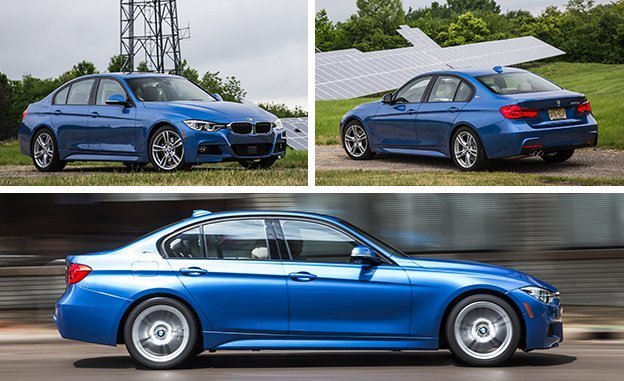A dip in the Toyota Prius pool might elevate your state of environmentally responsible bliss, but surely you’d miss the driving joy that hybrids sacrifice to trim their CO2 footprints. Good news: Salvation has arrived in the form of a plug-in-hybrid sedan that’s actually fun to drive. The 2016 BMW 330e sedan tested here exploits lessons learned from BMW’s i3 and i8 models (now part of the iPerformance sub-brand, along with plug-in-hybrid versions of the standard cars) to resolve the classic rub between low consumption and high performance.
This green edition of the world’s bestselling luxury sedan is expensive, with a starting price of $44,695, but it’s sure to be a hit with those interested in saving the planet without resorting to public transit.
The powertrain components are a 180-horsepower 2.0-liter turbocharged inline-four in the usual underhood location, teamed with an eight-speed automatic transmission and an 87-hp electric motor/generator. The AC power provider replaces the torque converter inside the ZF 8HP gearbox. Computer-controlled servos and clutches provide manual and automatic command over gear ratios and three different propulsion modes. A 7.6-kWh air-cooled lithium-ion battery lives unobtrusively under the trunk floor, while the 10.8-gallon gas tank rests beneath the rear seat.
To experience the joys of combustion-free driving, simply punch the eDrive button on the console to engage the Max eDrive mode. After an initial driveline shudder, there’s barely a whisper as the car motors toward the future. As more city centers around the globe ban vehicles that produce tailpipe emissions, this mode will be an excellent means of maintaining personal mobility. With gentle accelerator pressure, the iPerformance will motor up to a top speed of 75 mph for a maximum of 14 miles, according to BMW, assuming the battery was fully charged at the start. When the driver inevitably grows weary of turtle mode, pressing deeper on the accelerator pedal—say, to execute a safe pass—automatically fires up the turbo four-cylinder. This occurs so smoothly that the transformation is revealed more by the swing of the tach needle than by any engine rumble.
Mode two, called Auto eDrive, is the default setting. The only difference from the Max setting is that the baton passes from electric propulsion to engine power at 50 mph.
The third choice available through the eDrive button is a Save Battery mode so the car doesn’t squander stored electrical energy before it’s needed. Here, the AC machine operates as a generator powered by the engine to replenish the battery to the 50 percent level, assuring a few miles of zero-emissions driving. Of course, there are static charging options available as well. A standard 120-volt plug will replenish a fully depleted battery overnight (say, six or seven hours). BMW sells a 240-volt i Wallbox for $1080 plus installation, which drops the charge time to two-and-a-half hours. And a growing number of publicly accessible charge points can be found by using the 330e’s ConnectedDrive app.
Our $62,345 test car was endowed with six option packages adding up to $11,650 and eight free-standing options that together cost $6000. It tipped the scales at just less than 4000 pounds. A 320i we tested three years ago with a similar engine, an eight-speed automatic, and fewer options was lighter by 644 pounds, illustrating that green gear is never free from a mass standpoint.
That said, we bring you excellent news from the test track. With a gasoline/electric total of 248 horsepower at your disposal (versus 180 hp in the aforementioned 320i), the 330e is a sparkling performer. It hauls to 60 mph in a fleet 5.8 seconds and to 98 mph in the quarter-mile in just 14.3 seconds, beating the regular 2.0-liter model by 0.7 second and 0.8 second (and nearly matching the 240-hp 328i we ran through our 40,000-mile regimen). Hold the go pedal down, and this BMW tops out at 140 mph.
The 330e’s 171-foot stop from 70 mph was longer than the 320i’s braking distance by eight feet. Roadholding on our skidpad was even closer: 0.86 g for the 330e, versus 0.87 for the lighter 320i. Both BMWs were equipped with the same Bridgestone Potenza run-flat tires. A blast down our favorite back road revealed the 3-series verve we’ve grown accustomed to: not much steering feedback but excellent overall poise, suspension control over bumps and body motion, and a lust for the 7000-rpm redline. During deceleration, there’s no annoying change in pedal feel as regeneration is supplemented by friction braking. Noise measurements were a near match except for the hybrid’s 30-decibel murmur at idle versus the combustion car’s 43 decibels. Silence, don’t you know, is golden.
Gas mileage is the clincher. Tallying dollars of fuel and ignoring pennies of electricity, we averaged 30 mpg, within spitting distance of the EPA’s 31-mpg gas-only combined rating. Factoring in the electricity we drew from a 120-volt plug, the net efficiency still averaged 29 MPGe. That’s 8 mpg better than the mileage we observed with the 320i. Diligent reliance on the electric mode by a driver who rarely ventured beyond urban settings holds the promise of even better efficiency, but without the driving rewards that come with 3-series ownership.
Given the $10,550 base-price difference between a 320i automatic and the 330e plug-in hybrid, decades could pass before an 8-mpg advantage saves enough cents to make economic sense. That said, why not take the high road to environmental responsibility in a car that’s enjoyable to drive?
Powered by WPeMatico






